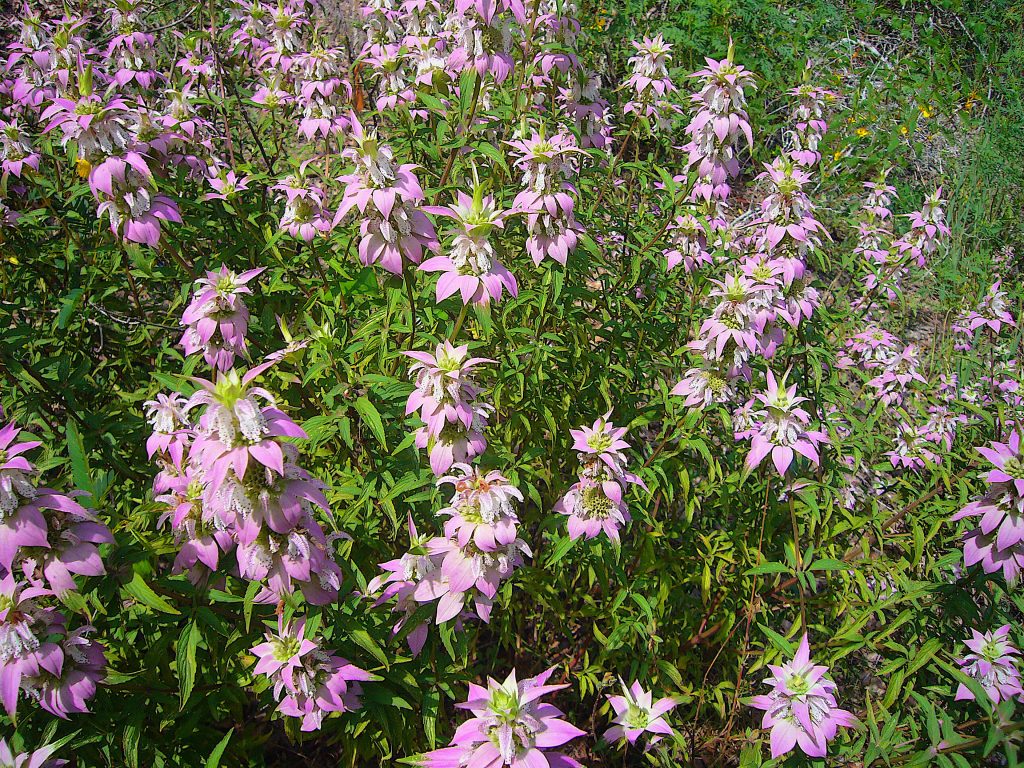
Horsemint (Monarda punctata) will be easy to find for several months. Photo by Green Deane
Wild mints can be prima donnas: Once on stage they hate to get off. Locally we would expect to see Horsemint, Monarda punctata in full bloom by September but it has pushed the season and can be found now. The species can also flower for several months. This week I saw a nice stand along a bike trail in south Vousia County, exactly where one would expect to find it: On a dry bank up from the trail. You can also find it in the same area near roads especially roads that cut through a sand hill. It was also starting to look pretty in Mead Garden last weekend. Look for the showy pink bracts. If you want to read about Horsemint you can go here.
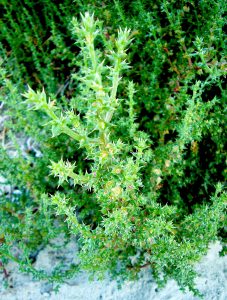
I find Russian Thistles in front of hotels on Daytona Beach. Photo by Green Deane
We shouldn’t forage along railroad tracks and you can blame it all on the Russian Thistle. This species, best known as the tumble weed that rolls across the wild west in movies, came with immigrants to southern South Dakota in the early 1870’s. Best guess is it contaminated their flax seed. By 1895 it reached New Jersey and California. The question was how? A professor who worked for the Department of Agriculture figured out the trains were spreading the seeds coast to coast. It was a remarkable idea at the time and brought him much fame. His solution to the unintentional distribution? Kill plants long railroad tracks. Thus began the practice of putting down some mighty and long-lasting chemicals to kill weeds sprouting amongst the iron rails. Railroad tracks are a good place to find seeds to take home and plant but not to find food. There have even been a few reported deaths from foraging along rail road tracks.
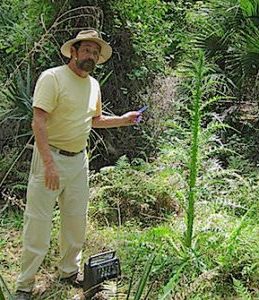
Foraging classes are held rain, shine, hot or cold. Photo by Nermina Krenata
Two well-known but less visited locations are on the class schedule this weekend: Lake Woodruff Preserve in Deland and Ft. Desoto in St. Petersburg. At Woodruff we will walk two two-mile loops, one along dike roads and one in the woods. Ft. Desoto has a persimmonhurst and a lot of poison ivy. We also see Goji Berries there.
Saturday, August 8th, Lake Woodruff National Wildlife Refuge, 2045 Mud Lake Road, DeLeon Springs, FL. 9 a.m. to noon. Lot’s of walking, no water, rustic bathroom. We meet where Mud Lake Road dead ends which is the extreme west end. (The address is the ranger station. We do NOT meet at the ranger station unless the gate to the refuge is close for some reason. Then we walk. It’s federal property and access can be sporadic.) Like Haulover Canal below this is wild Florida more than suburbia.
Sunday, August 9th, Ft. Desoto Park, 3500 Pinellas Bayway S. St. Petersburg Fl 33715. There is an entrance fee to the park. Meet at the fishing pier parking lot. 9 a.m to noon. (Same pier as the Egmont Key Ferry.)
Saturday, August 15th, Bayshore Live Oak Park, Bayshore Drive. Port Charlotte. 9 a.m. to noon. Meet at the parking lot on Bayshore Road across the street from Ganyard Street.
Sunday, August 16th, Haulover Canal, Merritt Island National Refuge, north of the Kennedy Space Center. Let’s try this again. An ascending bridge thwarted the last class there. 9 a.m. to noon. No drinking water on site, Port-O-Lets for bathrooms. Lots of Mosquitos (why it is called Mosquito Lagoon.) We meet at the west end of the northwest side of the canal. This class involves more than three miles of walking and can be strenuous.
For more information, to pre-pay or to sign up go here.
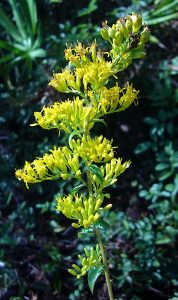
Goldenrod is ruderal. What does that mean? Read the article. Photo by Green Deane
Also seen blooming now is Goldenrod. It is a bit of a treasure hunt and disappointment. The treasure hunt is that one species is better than all the rest for tea, Solidago odora. It does grow here, has an anise flavor, but is hard to find. It’s reported in most counties but is not common. Goldenrod grows in about half of the United States, southwest to northeast. Other Goldenrod species can also be made into tea, perhaps all of them particularly for herbal applications, but they don’t taste anywhere near as good. In fact, after the “Boston Tea Party” of 1773 halted tea imports colonialists drank Goldenrod tea and even exported some to China. It did not catch on. However, every time I see a Goldenrod I pull off a leaf and crush it hoping to detect the tell-tale anise smell. It’s a golden treasure hunt.
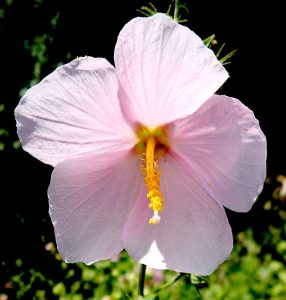
The mysterious Swamp Mallow. Photo by Green Deane
Hibiscus moscheutos is one of my mystery plants and ranges over much of the United States except for the high plains states and the west coast (and my native state of Maine.) The Swamp Rose Mallow is blossoming in damp spots locally particularly along the St. John River. I think its blossoming is more related to the shortening of the days than the weather per se. It has five separate petals united at the base and five green sepals. The blossom lasts only one day. They range from cream with a red or purple center to pale pink. It has a sticky, stringy juice. The question is, as a Hibiscus, are the blossoms edible or other parts? I have never found a reference to edibility. In fact, it seems only one Native American tribe used it medicinally, the Shinnecock who lived on what we now call Long Island. They used it for bladder infections. European settlers, however used the species for a wide variety of ailments. As several writers attest it “abounds with mucilage.” It is always interesting when such a wide-spread plant is rarely mentioned in the ethnobotanical literature. That could mean it wasn’t used, we didn’t ask, or they didn’t tell us. To read more about mallows go here.

Green Deane videos are now available on a USB.
Changing foraging videos: My nine-DVD set of 135 videos has been selling for seven years and are still available. They are the same videos I have on You Tube. Some people like to have a separate copy. A second option is a16-gig USB that has those 135 videos plus 15 more. While the videos can be run from the DVDs the videos on the USB have to be copied to your computer to play. They are MP4 files. The150-video USB is $99 and the 135-video DVD set is now $99. The DVDs will be sold until they run out then will be exclusively replaced by the USB. This is a change I’ve been trying to make for several years. So if you have been wanting the 135-video DVD set order it now as the price is reduced and the supply limited. Or you can order the USB. My headache is getting my WordPress Order page changed to reflect these changes. We’ve been working on it for over three weeks. However, if you want to order now either the USB or the DVD set make a $99 “donation” using the link at the bottom of this page or here. That order form provides me with your address, the amount — $99 — tells me it is not a donation and in the note say if you want the DVD set or the USB.

Green Deane Forum
Want to identify a plant? Perhaps you’re looking for a foraging reference? You might have a UFO, an Unidentified Flowering Object, you want identified. On the Green Deane Forum we — including Green Deane and others from around the world — chat about foraging all year. And it’s not just about warm-weather plants or just North American flora. Many nations share common weeds so there’s a lot to talk. There’s also more than weeds. The reference section has information for foraging around the world. There are also articles on food preservation, and forgotten skills from making bows to fermenting food.
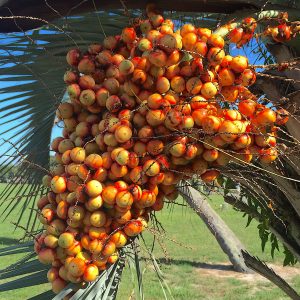
Pindo Palm fruiting can vary greatly. Photo by Green Deane
When something is ripe or ready to be harvested varies. A window of a few weeks is normal for most species but often can be extended. Pindo Palms can demonstrate that. I normally start looking for Pindo Palm fruit at the end of spring. Memorial Day reminds me their season is coming soon. By June I am usually eating some here and there. We are now early-August and I had my first Pindo Palm fruit today in Central Florida. The palm’s fruit is one of my favorite wild edibles. I definitely do not have a sweet tooth — in fact I carry the gene for fruit sugar intolerance — but Pindo Palm fruit is one I really like so I keep a close eye on them. While they like late spring and early summer you can find an odd one here and there fruiting around Thanksgiving or Valentine’s Day. They are also a hearty palm and can take a lot of cold temperatures.
This is weekly newsletter #417, If you want to subscribe to this free newsletter you can find the sign-up form in the menu at the top of the page.
To donate to the Green Deane Newsletter click here.

